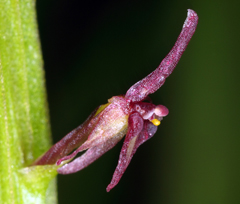
|
Family: Orchidaceae |
Herbs, terrestrial to semiepiphytic, glabrous. Roots few, fibrous, 0.3-1 mm wide. Stems swollen at base into pseudobulb, ± globose, glabrous. Leaves 1-3(-5), with sheathing base; blade elliptic, ovate, or lanceolate. Inflorescences terminal, racemes, spicate racemes, corymbose racemes, or subumbellate racemes; floral bracts inconspicuous, lanceolate, subulate, or triangular-acuminate. Flowers 2-160, resupinate or not, erect or spreading, sessile or minutely to strongly pedicellate; sepals spreading, distinct or lateral sepals basally connate, ovate, elliptic, or lanceolate, 1-6 mm, margins revolute or not; petals spreading or recurved, filiform to linear, lanceolate, or triangular, usually much narrower than sepals; lip ovate or lanceolate, cordate, unlobed to 3-lobed, concave or saccate, widest proximal to middle, base auriculate or truncate; column free; anther terminal; pollinaria 4, waxy; 1 pollinarium or 2 separate hemipollinaria; viscidia yellow or orange. Fruits capsules; previous year´s fruiting stem and capsules frequently present during current year´s anthesis. x = 14, 15, 18, ca. 20, ca. 21, 22. Sep and pet unlike, the lateral sep ±parallel behind the lip, the pet much smaller, spreading or recurved; lip relatively broad, variously shaped, often auriculate at base; column very short, in our spp. ca 1 mm or less; pollinia 4; small orchids from a corm, with 1-5 lvs at the base or near the middle of the low scape, and a terminal raceme of small fls. 200, irregularly widespread. Gleason, Henry A. & Cronquist, Arthur J. 1991. Manual of vascular plants of northeastern United States and adjacent Canada. lxxv + 910 pp. ©The New York Botanical Garden. All rights reserved. Used by permission. |
This project was made possible in part by the Institute of Museum and Library Services [MG-70-19-0057-19].
Powered by Symbiota



